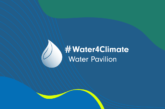A Few countries are contemplating long distance water transfer as in China and India to meet the exigencies of water shortage for multiple needs, while simultaneously addressing the enhancing efficiency and reducing demands. In arid and semi arid parts of countries in Asia the high population pressure has enhanced demand, and these are in some cases, in excess of supply resulting in a few basins getting closed (like Cauvery Basin, Peninsular India).
Lack of water storage infrastructure also causes heavy economic losses due to flooding and drought. Polluted water has high costs for human health. In short, adequate investments in water management, infrastructure and services can yield a high economic return by avoiding such related costs.
Viewed from the angle of the likely impact of climate change, varies ‘in-country ‘ studies as in India, project the possible intensification of hydrological cycle due to rise in temperature i.e., increase in rainfall but with increased variability in time and space leading to floods or drought ,flood like situations more frequently and more severely affecting the poor and vulnerable sections of the society at large.
Rain-Water Harvesting:
North Eastern Region falls in the highest rainfall zone of the country and enjoys typical monsoon climate, with conditions varying from tropical to temperate. The fast pace of changes in topography culminates in climatic changes within short distances. For instance, the average annual rainfall reaches a peak of 13,390 mm in the Cherrapunji–Mawsynram region in the Meghalaya plateau, while the northern and adjoining central areas in the same plateau that fall in the rain-shadow region need irrigation during most part of the year. The pre-monsoon showers (March–May) account for 25 per cent of annual rainfall, while bulk of the rainfall (67%) occurs during June–September, which constitutes the monsoon season.
Viewed in meteorological terms, the entire North Eastern Region is grouped under the Homogeneous Rainfall Region. With a mean annual rainfall of 2070 mm and mean summer monsoon rainfall of 1420 mm (69% of annual mean), the NER is the wettest of all the five homogeneous rainfall regions of India. The rainfall characteristics of NEI are distinctly different from those of other regions of India as well as the All India rainfall in several important aspects viz. variability and trends in annual and seasonal precipitation and conformity to the El Nino Southern Oscillation (ENSO) events.
The abrupt withdrawal of monsoon from the Northeast by the last week of September; followed by scanty rainfall in post-monsoon period (October–December) and winter season, the scope for agricultural activities during the rabi season gets limited. Delayed pre-monsoon rainfall and slow onset of monsoon along with partial distribution of rainfall not only entails the potential of leading to serious dislocations, but can also cause damage to the crops and also severe water shortage. On the other hand, excessive precipitation causes rapid run-off on steep slopes, resulting in heavy soil loss as well as siltation of riverbeds.
In this regard, it has been observed that rainwater harvesting can be implemented as a viable alternative to conventional water-supply schemes in the region, considering the fact that any land anywhere can be used to harvest rainwater. Rainwater harvesting besides helping meet the ever-increasing demand for water, helps reduce run-off which is choking storm drains, reduce flood hazards, augment the groundwater storage and control the decline in the water level, improve quality of groundwater and reduce soil erosion. This is considered to be an ideal solution for water problem, where there is inadequate groundwater supply or where surface resources are either not available or insufficient. Rainwater is bacteriologic ally pure, free from organic matter and soft in nature.
The structures for harvesting rainwater are simple, economical and eco-friendly. The subsistence agriculture in the hilly northeastern region can be successfully changed into a profit-earning enterprise by tapping and utilizing rainwater in limited quantities. Rainwater harvesting, irrespective of the technology used, essentially means harvesting and storing rainwater in days of abundance, for use during the lean days.
Storing of rainwater can be done in two ways: (i) in an artificial storage and (ii) in the soil media as groundwater. A demand–supply analysis is required while designing water-collection tanks. Factors such as amount and frequency of rainfall, run-off coefficient of the collecting surface, number of users, daily requirement and dearth period are important for calculating the size and capacity of the storage tank.
In domestic rooftop rainwater harvesting systems, rainwater from the roof of a house is collected in a storage vessel or tank for use during the periods of scarcity5. Usually these systems are designed to support the drinking and cooking needs of the family at the doorstep. Such a system usually comprises a roof, a storage tank and guttering arrangement to transport water from the roof to the storage tank. In addition, a first flush system to divert the dirty water during the first rains and a filter unit to remove debris and contaminants before water enters the storage tank are also provided.
Rainwater can be collected in large quantities in lined ponds. Generally, big ponds are constructed and subsequently lined with non-permeable sheets like agrifilm, silpaulin, HDPE or nylon, or with a semi-permeable coating of clay to reduce the seepage losses. The roof water, run-off water (after filtration, for potable/household purposes) or spring water may be diverted to the pond. A large quantity of water, generally 50,000–20,00,000 can be harvested using such ponds, which in turn may be used for irrigation or household purposes. Moreover, it is durable and easy to construct with less maintenance cost.
Normally three types of ponds, viz. embankment type, excavated (dugout) and dugout-cum-embankment type are constructed for collection of excess run-off. Embankment type and dugout-cum-embankment type of ponds are feasible in hilly and undulating topography. Embankment type of ponds are made by constructing a small length of dam across a water course, whereas dugout-cum-embankment type of ponds are made by excavating a site surrounded by hillocks from two or three sides and making the embankment from the excavated soil on the remaining sides. In flat areas, where these two types of ponds are not feasible, dugout ponds are constructed.
To meet the requirements of this target, productivity of rain fed farming systems will have to be increased. The efforts under this target will focus on the opportunities for improving rain fed farming potential to boost yields and income, especially in areas of low productivity.
Measures to improve land and water productivity may include:
Making more rainwater available to crops when most needed (capture water -rainwater harvesting, soil and water conservation-, and using it -deficit irrigation; supplementary irrigation etc.);
- on-farm water management to minimize water losses by evaporation;
- use of improved crop varieties;
- use of improved cropping systems and agronomics, such as conservation tillage;
- development of financial frameworks to provide incentives for the adoption of best practices and new technology;
- use of low quality water in non-conventional (not for direct human consumption) applications such as forestry;
- Evaluation of rainfall patterns to determine quantity and quality available for agriculture use and rethinking crop scheduling.
Increased land and water productivity in rainfed systems will imply technologies and practices but also need to be supported by capacity building, financing, marketing systems and adequate policies and institutional changes. The main stakeholders in the improvement of rainfed systems will include farmers, land-owners, extension services in agriculture and rural development, local governments, regional/state governments and federal governments. Costs will necessarily
Role of Civil Society:
Concomitantly, the civil society is better placed to ensure people’s participation and mobilization of volunteers. Volunteers of a civil society come from the grassroots and such they have a close rapport with the people. Once these volunteers are involved in the project then eliciting people’s participation in that project is not a difficult proposition. Rather people join hands with the volunteers and such an eventuality is bound to ensure the success of the project to a satisfactory level. And under the prevailing ambience, people’s participation is imperative for the success of any project/scheme.
Another advantage of involving the civil society in water-related projects is that it works as a link between the people who are recipient of the benefits of the project and the government which is the initiator of the project. While the project is in progress, the civil society can bring to the notice of the government the exact position without any hindrance whereas government officials may hide certain facts for fear of being reprimanded.
Meghalaya Model :
The IWF is a non-profit organization established for the purpose of generating a heightened public awareness at national level in India and sub-regional level in Asia, regarding the vital role water plays in the population’s daily lives, and the impact it generates on human health, economic growth and environmental sustainability. As a knowledge partner of Meghalaya Basin Development Authority (MBDA), Government of Meghalaya, has cooperated with MBDA in the development of Small Multipurpose Reservoirs (SMRs) for irrigation purposes, integrated water management and livelihood improvement in the state of Meghalaya. The other objectives of this SMR, inter alia include:
- Making the best use of technological intervention and opportunities for harvesting and recycling rain water for domestic water supply, irrigation, fish farming, and other productive livelihood generation purposes. For example, cascading SMRs of various sizes and designs can be used to meet the various water use requirements such as upstream reservoir could be used for water supply for drinking and irrigation purposes and downstream reservoirs for fish farming.
- Undertaking preventive and protective measures for mitigating the impact of rainfall causing accelerated erosion due to overland flow and denudation due to drainage channel–flow.
- Providing income earning opportunities throughout the year.
- Generation of power through micro (upto 100 kW) hydel power stations. For setting up of Micro-Hydel-power stations this project would work along with the existing government schemes and other renewable power generation schemes of Ministry of New and Renewable Energy (MNRE).
The enhanced availability of water, because of storage at the SMRs, would boost the other ongoing government schemes such as (Rashtriya Krishi Vikas Yojna (RKVY), Accelerated Irrigation Benefit Program (AIBP), Command Area Development Program (CADP) etc. since these schemes typically fund the downstream infrastructure for providing water access to users for potable and irrigation purposes
- Increasing livelihood opportunities in rural Meghalaya on a sustainable basis through greater and regular access to water. Availability of water will surely enhance capabilities of tribal households to select appropriate livelihood opportunities and for ensuring sustainable income and greater water and food security.
- This project will assist the people in Meghalaya in dealing with climate change and biodiversity challenges by providing a holistic and efficient management approach for an integrated management of the state’s water resources.
- Improving overall quality of life in the project areas.
Resultant Impact:
The IWF cooperation with the MBDA has proved instrumental in persuading the Government of Meghalaya in undertaking following major initiatives in water sector:
- The State Government has launched recently Water Mission which aims at promoting Integrated Water Resource Management (IWRM) and building of water-based and water-related livelihood and enterprise opportunities for the people.
- Water has been made key to State government’s initiative of Integrated Basin and Livelihood Development Program (IBLDP), which addresses various issues of sustainable development related to water and natural resource management, capacity building, development of infrastructure etc., with climate change perspective.
- A semblance of convergence has been set in motion between different departments of the Government of Meghalaya in managing water resources.
- The state government has adopted new state water policy and water laws which are designed to promote Integrated Water Resource Management.
The Need of the Hour:
- Ensuring resilient agriculture calls for the need to realize that our agricultural water lifeline is groundwater and our dependence on groundwater is increasing at a brisk rate.
- The groundwater lifeline can be best sustained through local water systems, and not through big irrigation projects.
- Rain-fed areas should be accorded priority on par with big irrigation projects. Besides, the climate change imperatives also indicate the need for increasing the moisture holding capacity of the soils, rehabilitating the existing local water systems and building more of them where possible and necessary.
- As agriculture sector is the biggest consumer of water resources, hence shrinking water resources call for devising effective measures of water use efficiency for the agriculture.
- The management of water resources is crucial for India’s agriculture and the development of water resources has received substantial focus. However, the emphasis has been mainly on the technical side.
- The development of the necessary institutions required for effective management of the resource has received inadequate attention, and this has led to an emerging water crisis.
- Apart from developing essential institutional mechanism to focus on promotion of water use efficiency, equal stress needs to be emphasized on capacity building of the farmers by sensitizing them about judicious use of water resources with the help of civil society.
- There is also need for inter-sectoral convergence between ministries/departments at the Centre as well as between the Centre and the states in this regard.
- Involvement of civil society can go a long way in ensuring water use efficiency for attainment of sustainable and resilient agriculture.
………………………………………………………………………………………………………………..
Dr Arvind Kumar is a renowned water activist and the President of India Water Foundation, a non-profit organization established for the purpose of generating a heightened public awareness at national level in India and sub-regional level in Asia, regarding water and its impact on human health, economic growth and environmental sustainability.
_______________________________________
Published in Maharashtra Economic Development Council (MEDC), Monthly Economic Digest (July 2013)



